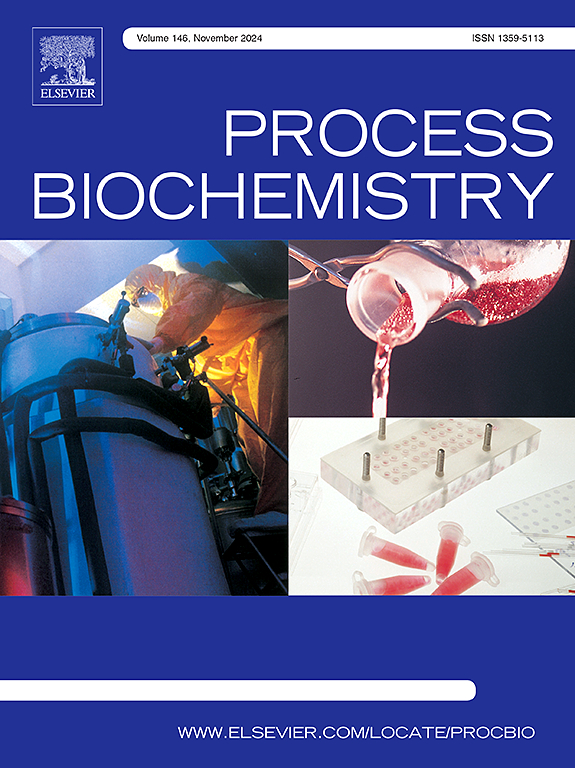Lipase separation from a new source of Bacillus cereus NC7401 using a cost-effective and eco-friendly approach of surfactant/xylitol biphasic system
IF 4
3区 生物学
Q2 BIOCHEMISTRY & MOLECULAR BIOLOGY
引用次数: 0
Abstract
In the present study, lipase was successfully separated for the first time from Bacillus cereus NC7401 using a novel micellar aqueous biphasic system (ATPS) composed of xylitol and surfactants. ATPS offered eco-friendly, simple, and cost-effective enzyme separation. A fresh culture of Bacillus cereus NC7401 was inoculated, and enzyme production was carried out using a basal medium. After centrifugation to separate cells, the culture filtrate was used for enzyme activity assays. Three ATPS systems composed of xylitol and surfactants (Triton X-100, tween-80, and sodium dodecyl sulfate) were evaluated to identify the optimal composition. Phase diagrams were constructed to determine appropriate concentrations of surfactants and xylitol. ATPS composed of Triton X-100 (6 % w/w) and xylitol (40 % w/w) achieved a maximum purification fold of 15.4 and a yield of 96 %. Adding 5 % NaCl to the crude lipase extract raised the separation factor to 16.9. The separated lipase exhibited optimal activity at 40–50 °C and pH 7.0. Fe+ 2 stimulated, while Ni+2 showed an inhibitory effect on lipase partitioning as determined by titrimetric analysis. The high separation efficiency, yield, and reduced processing time of the surfactant/xylitol ATPS highlighted its potential for industrial applications in biocatalysis, pharmaceutical processing, and other enzyme-dependent processes.
表面活性剂/木糖醇双相体系分离蜡样芽孢杆菌NC7401脂肪酶的研究
利用木糖醇和表面活性剂组成的新型胶束双水相体系(ATPS),首次从蜡样芽孢杆菌NC7401中成功分离出脂肪酶。ATPS提供了环保、简单、经济的酶分离。接种鲜培养蜡样芽孢杆菌NC7401,在基础培养基上产酶。离心分离细胞后,用培养滤液进行酶活性测定。对木糖醇和表面活性剂(Triton X-100、吐温-80和十二烷基硫酸钠)组成的三种ATPS体系进行了评价,以确定最佳组成。构建相图以确定表面活性剂和木糖醇的合适浓度。Triton X-100(6 % w/w)和木糖醇(40 % w/w)组成的ATPS最大纯化倍数为15.4倍,收率为96 %。在脂肪酶粗提物中加入5 % NaCl,分离系数达到16.9。分离得到的脂肪酶在40 ~ 50℃、pH 7.0条件下活性最佳。铁+ 2刺激,而Ni+2对脂肪酶分配有抑制作用,通过滴定分析确定。表面活性剂/木糖醇ATPS具有分离效率高、产率高、加工时间短等特点,在生物催化、药物加工和其他酶依赖过程中具有广阔的工业应用前景。
本文章由计算机程序翻译,如有差异,请以英文原文为准。
求助全文
约1分钟内获得全文
求助全文
来源期刊

Process Biochemistry
生物-工程:化工
CiteScore
8.30
自引率
4.50%
发文量
374
审稿时长
53 days
期刊介绍:
Process Biochemistry is an application-orientated research journal devoted to reporting advances with originality and novelty, in the science and technology of the processes involving bioactive molecules and living organisms. These processes concern the production of useful metabolites or materials, or the removal of toxic compounds using tools and methods of current biology and engineering. Its main areas of interest include novel bioprocesses and enabling technologies (such as nanobiotechnology, tissue engineering, directed evolution, metabolic engineering, systems biology, and synthetic biology) applicable in food (nutraceutical), healthcare (medical, pharmaceutical, cosmetic), energy (biofuels), environmental, and biorefinery industries and their underlying biological and engineering principles.
 求助内容:
求助内容: 应助结果提醒方式:
应助结果提醒方式:


